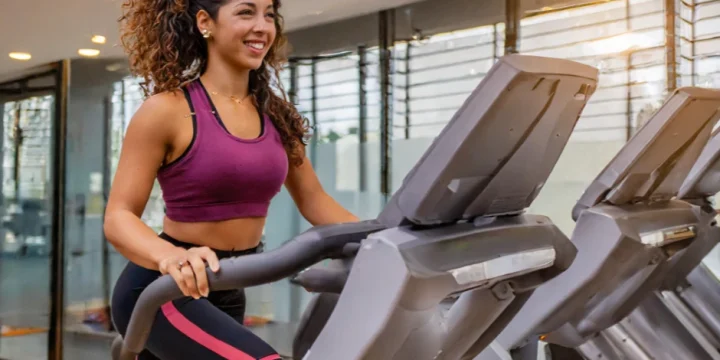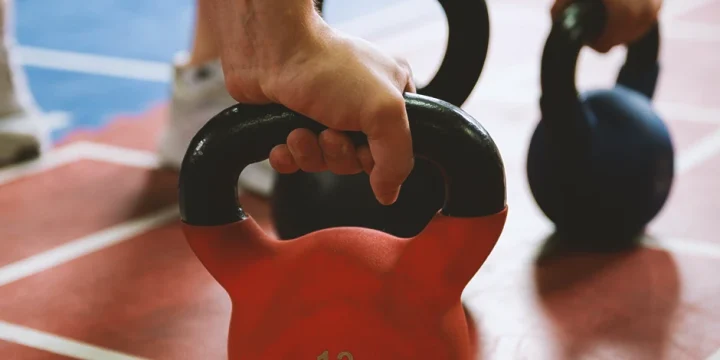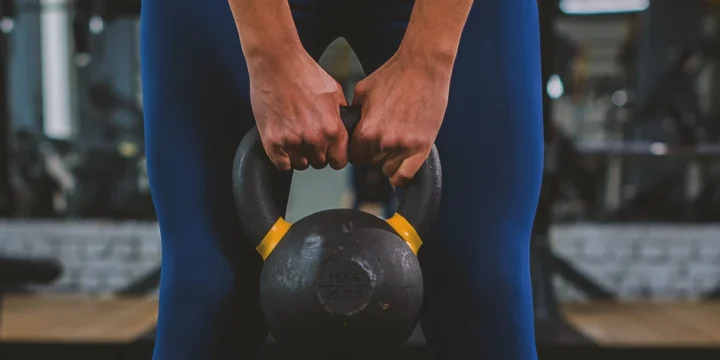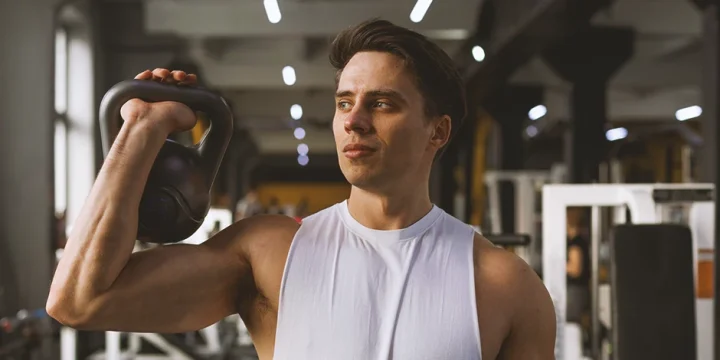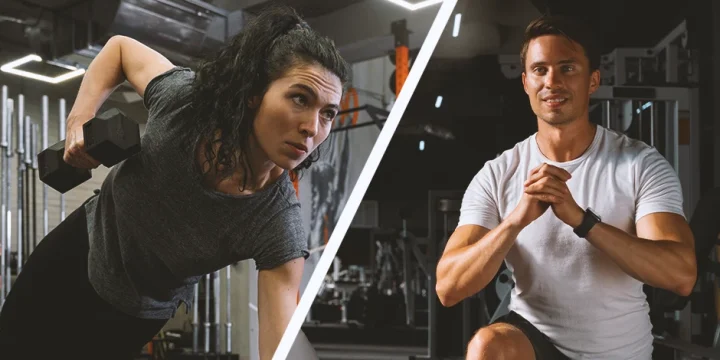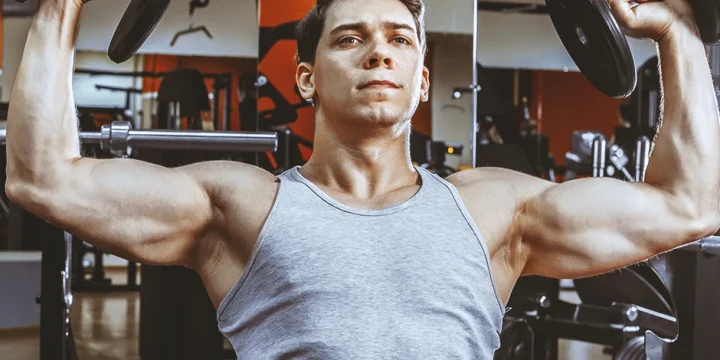Kettlebells are an excellent tool for functional training, which uses motions seen in everyday life, such as climbing stairs, walking, lifting, and bending.
Kettlebell HIIT workout causes excessive post-exercise oxygen consumption (EPOC), sometimes known as "afterburn." These exercises raise your heart rate, burn fat, and provide a total-body burn.
As a certified fitness trainer, I've incorporated much equipment in my HIIT training regimen, and kettlebells stood out as the best.
This article will detail my expertise on the best kettlebell HIIT workout, their benefits, and how to program them into your training regimen.
Quick Summary
- Kettlebell HIIT workouts include kettlebell squat and press, kettlebell swings, kettlebell goblet squats, kettlebell clean and press, kettlebell snatch, and Russian kettlebell twist.
- Kettlebell HIIT workout is an exercise that combines bodyweight aerobic and cardiovascular demands with external weight via the usage of a kettlebell.
- Research by the NIH suggests that HIIT can significantly elevate heart rate, promoting better cardiovascular health and enhanced calorie burning after the workout.
- In my opinion, kettlebell HIIT workouts offer a dynamic and efficient approach to strength and endurance training, suitable for varied fitness goals.
The Kettlebell HIIT Workouts

Kettlebell Squat and Press
The kettlebell squat and press is a single-arm thruster that simulates the bottom section of a deep kettlebell Turkish get-up or snatch.
This will quickly fire up your aerobic system while targeting your core, deltoid, and lats.
How to perform:
- Begin in the rack posture with the kettlebell in your left hand.
- If required, extend your right arm for balance.
- Squat as deeply as possible while maintaining tension.
- Explode from the ground and attempt to hurl the kettlebell through the roof (don't let go).
- Keep the top stable for a beat.
- Return your left hand to the rack position.
- Repeat for the desired number of reps.
Kettlebell Swing
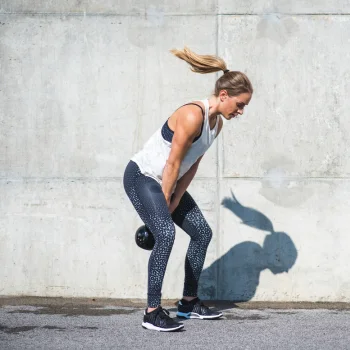
Kettlebell swings are a high-intensity, low-impact workout that improves cardiovascular fitness, power, and explosiveness.
While kettlebell swings are a full-body exercise, they focus mostly on the muscle groups in the back of the body.
Kettlebell swings have transformed my workouts, offering a mix of intensity and low impact that has significantly boosted my cardio fitness.
How to perform:
- Stand tall with your feet shoulder-width apart, still grasping the kettlebell.
- Maintain long, loose arms while pulling the shoulder blades together and activating your core.
- Soften your knees, move your weight onto your heels, and drop your buttocks behind.
- Explode through your hips while driving through your heels to send the load swinging upward from the quadriceps. With your arms outstretched, aim for chest height.
- To get to this position, snap the hips through while engaging your core and squeezing your glutes.
- Allow the weight of the kettlebell to do the job as you prepare your body for the following repetition.
- Return your weight to your heels, hinge at your hips, and load your glutes and hamstrings.
- Allow the kettlebell to ride backward between your feet as you receive its weight.
- Drive through your hips and heel to repeat as the kettlebell moves from backward to forward.
"Kettlebell swings are a full-body workout focusing on the glutes, hamstrings, and core. It is a functional exercise movement that increases muscular mass, power, and strength."
- Tara Laferrara, Certified Personal Trainer
Kettlebell Goblet Squat
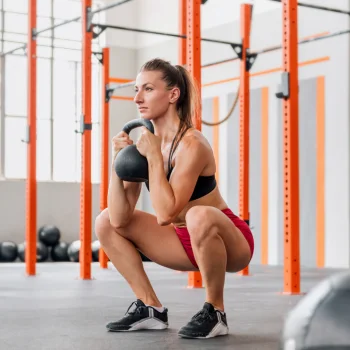
Aside from their simplicity, kettlebell goblet squats offer other advantages.
The kettlebell goblet squat is frequently used to teach proper squat technique because it helps you to maintain your torso erect and sit back with your hips.
The goblet squat works the core, upper body, and lower body.
The kettlebell goblet squat is a complex activity that engages many muscle groups simultaneously.
How to perform:
- Hold the kettlebell near your upper chest, either by its handle or upside down, with your feet slightly wider than your hips.
- Maintain a strong core and an assured chest.
- Sink the hips back and drop into a squat with the knees in line with your toes.
- The thighs should be parallel or lower at the bottom of the squat, and your elbows should be between your knees.
- Drive back up, tensing the glutes at the peak and driving into your heels.
- Repeat for the desired number of reps.
Kettlebell Clean and Press
The kettlebell clean and press engages both the lower body and upper body explosively, benefiting whole-body power and cardiovascular fitness.
How to perform:
- Begin with both feet shoulder-width apart and the kettlebell in your left hand, arm straight.
- Consider "jumping" the weight to your left shoulder.
- Bend your legs slightly and consider "throwing" the weight up from the shoulder area.
- Keep your left hand fully extended in the top position.
- Return the weight to its starting position.
- Repeat for reps.
Kettlebell Snatch
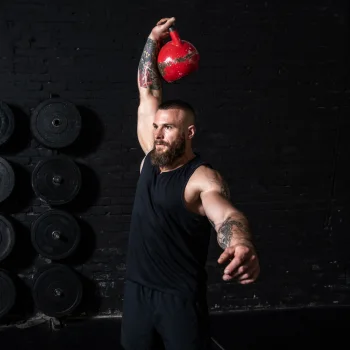
The kettlebell snatch is a complex full-body workout. It strengthens the entire posterior chain of your body (rear side-butt, hamstrings, back) while also increasing strength, power, cardiovascular fitness, and coordination.
How to perform:
- Hold the inside corner of the kettlebell handle.
- Begin with a swing, but hold the kettlebell close to your body as if facing a wall.
- Bring the kettlebell toward you at chest height, then press your hand up and through.
- Don't wait for the kettlebell to fall over; bang it about.
- Flip the kettlebell over from the top position, starting with the elbow, and maintain the kettlebell close.
- As with a swing, absorb the kettlebell load at the bottom and repeat.
- The arm is only straight at its peak and bottom.
- As with the swing, use snapping hips to generate power.
Learn More: Best Kettlebell Back Exercises
Kettlebell Russian Twist
The Russian kettlebell twist is a non-calisthenic version of the more often observed Russian twist; both are open kinetic chain isolation activities used for muscle hypertrophy and neurological strengthening.
To begin doing a Russian kettlebell twist, set a cushion on the floor to avoid extra pain or discomfort.
Use a relatively lightweight kettlebell, particularly if you are new to the activity.
Adding the Russian kettlebell twist to my sessions has notably improved my core strength and muscle coordination.
How to perform:
- Lie down with the weight on your stomach.
- Raise your feet, shoulders, and knees off the ground while holding the kettlebell off your belly.
- Twist the shoulders (and hands) left and "place" the kettlebell close to your left hip.
- Reverse the course immediately and "place" the kettlebell slightly off the right hip.
- Complete all of the required repetitions.
Related: The Best Kettlebell Workouts
What Is HIIT?
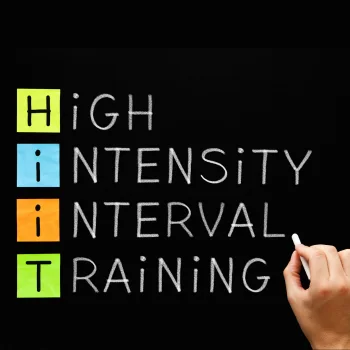
HIIT is an acronym for High-Intensity Interval Training. As the name indicates, it is interval exercising with high intensity. It consists of brief bursts of serious anaerobic activity followed by shorter rest periods in intervals.
For instance, 20 seconds of intensive effort followed by 10 seconds of rest, or 30 seconds of working out followed by 15 seconds of rest done for a predetermined number of rounds.
According to a study published by the National Institutes of Health (NIH), HIIT aims to raise your heart rate to 85-95% maximum during the active phase and then maintain it at 60-70% throughout the rest interval, which is why rest times are brief [1].
This type of rigorous HIIT workout benefits the cardiovascular system, metabolism, fat oxidation, and cognition (brain capacity).
A pivotal study by the National Institutes of Health (NIH) shows that with HIIT, you will experience an EPOC response (post-exercise oxygen consumption), commonly known as an "afterburn."
You will burn extra calories after your workout (for approximately 48 hours) than you would ordinarily (a metabolism boost) [2].
Why Use Kettlebells?
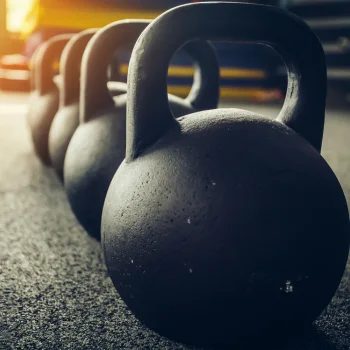
You use kettlebells because they train many muscular groups at once.
Holding a heavy object by the handle works your arm, back, leg, abdominal, and shoulder muscles.
A study by the National Institutes of Health (NIH) shows the tension in your muscles aids in their strengthening. The strain on your bones promotes the creation of new bone cells [3].
Kettlebells can also help you improve your posture and balance.
"With the load in before you, the back muscles must straighten up further to counterbalance the power of the kettlebell dragging you forward."
- Nancy Capparelli, Physical Therapist
The Best Kettlebell HIIT Workout Programming

There are a few reliable methods to schedule a kettlebell HIIT workout program, which would resemble a regular bodyweight HIIT exercise but with kettlebell movements.
A kettlebell HIIT workout session might include a single kettlebell exercise or a series of activities performed in circuits.
Kettlebell 60 x 60 HIIT
This one encompasses 60 seconds of intense effort and 60 seconds of active recovery.
This implies you must incorporate some bodyweight activities into your recovery phase.
Example:
- 60 seconds of kettlebell snatch (left side)
- 60 seconds running in place (or any other low-intensity exercise)
- 60 seconds of kettlebell snatch (right side)
- 60 seconds running in place (or any other low-intensity workout)
- Repeat five to six times
- If you execute exercises like two-handed swings, you don't have to swap sides; therefore, increase the number of sets to ten
Kettlebell 40/20 or 30/15
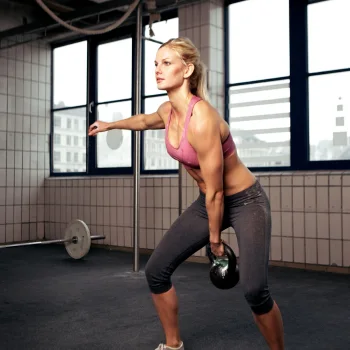
This is a circuit-based kettlebell HIIT workout consisting of a 40 seconds workout followed by 20 seconds of rest or 30 seconds of training followed by 15 seconds, i.e. 30/15:
- 30 seconds of kettlebell swinging, followed by 15 seconds of rest
- 30 seconds of kettlebell snatch, followed by 15 seconds of rest
- 30 seconds of bent-over kettlebell rowing, followed by 15 seconds of rest
- 30 seconds of kettlebell goblet lunges, followed by 15 seconds of rest
- Repeat four to six rounds
Kettlebell Tabata
A kettlebell tabata high-intensity interval training (HIIT) workout generally consists of one exercise performed 5-10 times for 20 seconds of working out and 10 seconds of recovery.
This is among the shortest kettlebell training routines. The kettlebell tabata HIIT exercise is ideal for after a regular conditioning session - it's an intensive finisher.
Example:
- Twenty seconds of kettlebell swings, followed by 10 seconds of rest
- Repeat ten times
- If you're performing one-handed swings, switch hands with each interval
Read More: Tabata Workouts to Boost Your Cardio and Endurance
Kettlebell Every Minute On the Minute (EMOM)
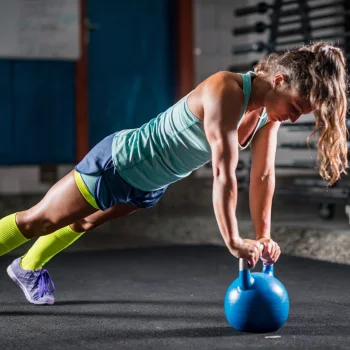
This one requires you to perform an activity (such as push-ups) every minute on the minute. You will establish a repetition target, but the kettlebell exercises should ideally last 30-40 seconds.
Remember that you will be performing every workout on the minute, so you can only rest from the time you finish the final repetition until the minute is up.
With EMOMs, even as a beginner, you may move fast while maintaining perfect form. As a result, the more aggressive you are, the longer your recovery period will be.
It performs well because if you're explosive, ayour heart rate will be higher; if you are not, you will have less rest time, which will also keep your heart rate up.
Here's an illustration:
- 20 repetitions of kettlebell two-handed swing
- 15 repetitions of the kettlebell goblet squat
- 20 repetitions of kettlebell (10 on each side)
- 20 repetitions of kettlebell two-handed sumo deadlift
- Repeat for four or five rounds
Benefits of Kettlebell HIIT Workout

Increased Calorie Burn
Including resistance in your HIIT practice may help you lose body fat compared to if you only use your body weight.
I experienced that integrating kettlebells into my HIIT workouts has not only helped me shed body fat but also build muscle.
Using the 20-pound or 30-pound kettlebell will help the body gain muscle while increasing your metabolism and capacity to lose weight.
Stronger Ligaments and Joints
Kettlebell exercises often include fluid, multi-joint motions, which means they can assist in building strength and flexibility in a manner that is more closely similar to how the body moves throughout regular activities.
Building strength in the ligaments and joints will not only assist you in avoiding injury during exercises but also help you avoid harm in the long run.
When combined with an optimal diet, the best post-workout supplements, and some low-to-moderate intensity aerobic exercise, you develop a comprehensive training program that should result in gains in performance and body composition.
Improved Balance
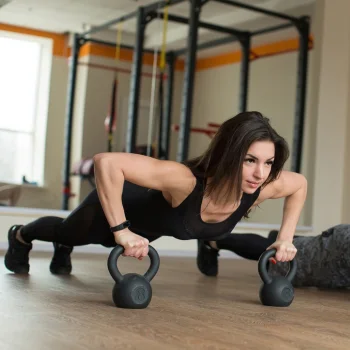
The kettlebell is not like dumbbells or any other handheld load. Since the center of gravity is placed a distance from the arm, they provide a unique set of obstacles to your body.
Kettlebell exercises utilize your entire body.
The center of gravity fluctuates as you move the kettlebell, forcing your body to use smaller, stabilizing muscle groups to sustain the action and body position.
Better balance, like stronger joints and ligaments, can boost performance, reduce injury, and maintain you healthy and strong.
Added Core Strength, Tone, and Stability
The kettlebell can help you gain stability and core strength. While kettlebell exercises normally do not isolate specific muscles, they significantly influence your core.
For the length of your sweat session, your shifting center of gravity actively activates the muscles in your trunk.
Stronger abs and back will enhance your balance, posture, and stability, allowing you to accomplish daily duties more comfortably.
This can also help to prevent injuries and back discomfort while placing less strain on your joints. Working these muscle groups will also tone them.
FAQs
Is It OK To Do Kettlebell Swings Every Day?
Yes, it is OK to do kettlebell swings every day. Kettlebell swing may assist you in burning more calories, increasing your endurance, burning fat, minimizing low back discomfort, and improving your overall body posture. You can perform them daily to acquire the best results.
How Many Calories Does a 30-Minute HIIT Kettlebell Workout Burn?
The number of calories burned in a 30-minute HIIT kettlebell workout will be approximately 115 if you weigh 160 pounds.
Is 20 Minutes of Kettlebells Enough?
Yes, 20 minutes of kettlebells are enough. This largely depends on your objectives and how you will use the kettlebell. Twenty minutes of high-intensity interval training with a kettlebell is enough to burn more calories for weight loss.
References:
- https://www.ncbi.nlm.nih.gov/pmc/articles/PMC8289951/
- https://pubmed.ncbi.nlm.nih.gov/14599232/
- https://www.ncbi.nlm.nih.gov/pmc/articles/PMC6279907/
About The Author
You May Also Like
